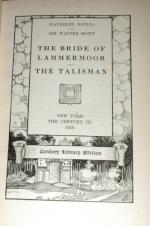Even her husband, it is said, upon whose fortunes her talents and address had produced such emphatic influence, regarded her with respectful awe rather than confiding attachment; and report said, there were times when he considered his grandeur as dearly purchased at the expense of domestic thraldom. Of this, however, much might be suspected, but little could be accurately known: Lady Ashton regarded the honour of her husband as her own, and was well aware how much that would suffer in the public eye should he appear a vassal to his wife. In all her arguments his opinion was quoted as infallible; his taste was appealed to, and his sentiments received, with the air of deference which a dutiful wife might seem to owe to a husband of Sir William Ashton’s rank adn character. But there was something under all this which rung false and hollow; and to those who watched this couple with close, and perhaps malicious, scrutiny it seemed evident that, in the haughtiness of a firmer character, higher birth, and more decided views of aggrandisement, the lady looked with some contempt on her husband, and that he regarded her with jealous fear, rather than with love or admiration.
Still, however, the leading and favourite interests of Sir William Ashton and his lady were the same, and they failed not to work in concert, although without cordiality, and to testify, in all exterior circumstances, that respect for each other which they were aware was necessary to secure that of the public.
Their union was crowned with several children, of whom three survived. One, the eldest son, was absent on his travels; the second, a girl of seventeen, adn the third, a boy about three years younger, resided with their parents in Edinburgh during the sessions of the Scottish Parliament and Privy Council, at other times in the old Gothic castle of Ravenswood, to which the Lord Keeper had made large additions in the style of the 17th century.
Allan Lord Ravenswood, the late proprietor of that ancient mansion adn the large estate annexed to it, continued for some time to wage ineffectual war with his successor concerning various points to which their former transactions had given rise, and which were successively determined in favour of the wealthy and powerful competitor, until death closed the litigation, by summoning Ravenswood to a higher bar. The thread of life, which had been long wasting, gave way during a fit of violent and impotent fury with which he was assailed on receiving the news of the loss of a cause, founded, perhaps, rather in equity than in law, the last which he had maintained against his powerful antagonist. His son witnessed his dying agonies, and heard the curses which he breathed against his adversary, as if they had conveyed to him a legacy of vengeance. Other circumstances happened to exasperate a passion which was, and had long been, a prevalent vice in the Scottish disposition.




